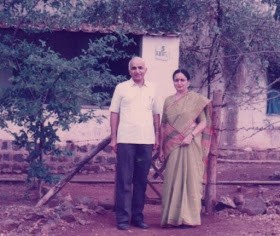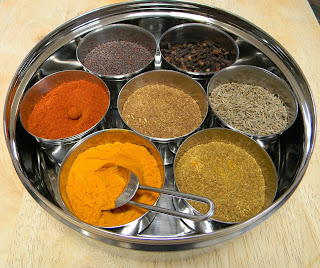As one of the primary officials of Mumbai Marathi Sahitya
Sangh, her focus is firmly, the world of Marathi literature. Whether it was the
chairpersonship of Mumbai Marathi Sahitya Sangh or of the All India Marathi Sahitya
Sangh, Usha Tambe has handled both very skillfully. In any organization, there
are as many opinions as there are people. While dealing with the complex issues
that arise, the soft-spoken Usha Tambe has demonstrated that she has the inborn
ability to tactfully and gently handle any situation.
Usha Tambe née Thakur was born in Amravati in a staunch Gandhian household, to parents who were freedom fighters. Illustrious visitors such as Union health minister Amrita Kaur, Governor of Punjab, Kaka Saheb Gadgil regularly graced her home. Naturally, with this background, her path to a master’s degree in English literature was assured, but above that she earned a gold medal that year. Soon she was married to a suitable engineer groom and fully immersed herself into her new role as Usha Shashikant Tambe. Shashikant Tambe a man of few words, was himself well read, but in the field of science. Reminiscing about an incident in the early years of marriage, Usha Tambe recalls; after watching the movie Mughal-e-Azam while she was animatedly discussing the movie in great detail, Shashikant had only one observation, “ The movie shows Anarkali being entombed in bricks….that was wrong, because such bricks did not exist in the time of Akbar!” Both Usha and Shashikant are artistic and engaged but in very different ways. What the poetic mind of Usha could not see, was quickly grasped by her executive engineer husband. Usha Tambe was living a comfortable, fulfilled and happy life as wife of Shashikant Tambe and mother of two children, when they had to relocate to Mumbai due to his job. Until then Shashikant had worked in towns like Yeldari, Nagpur and Amravati in the Public Works Department. The move to Mumbai changed their lives completely. Usha decided to work, and hence started teaching English at Bandodkar college in Thane. Very quickly she established herself as a professor to be respected and heard. Over time she became one of the most admired members of the faculty. It was around this time that she got acquainted with Mumbai Marathi Sahitya Sangh. She got the golden opportunity to interview well known writer Pupul Jaykar who had written the bestseller “Indira” and its translator Ashok Jain, the former in English and the latter in Marathi, simultaneously. The interview was very engrossing because of Usha Tambe’s precision, positive personality, and her ability to engage the panel in interesting conversation. After this, she was warmly welcomed in the world of Marathi literature in Mumbai. She started writing for newspapers. Her book reviews of the works of literary giants, rich in variety, published in several newspapers, became famous. Examples are; R.C. Dhere’s “Bharatiya Rangabhoomichya Shodha”, “Lokasanskrutiche Upasak”; “Madhyama” written by Ashok Kelkar, “Vyaktirekha” written by Y.D. Phadke; “Maalangatha” written by Indira Sant; “Dalit Sahityache Soundaryashastra” written by Sharankumar Limbale; “Manatle Abhal” by Aruna Dhere; “Samantar” by Vijaya Rajyadhyaksha. Her specialization being English Literature, Usha Tambe has written a lot about books in that language.
Now, Usha Tambe pivoted firmly towards writing her original works. While she was familiar with the world of academics and literature, Shashikant Tambe was completely immersed in his professional work of engineering projects of roads and bridges and developing infrastructure. He had rapidly risen to the post of Chief Engineer and Usha Tambe was subconsciously absorbing the construction projects he was involved in. Many times, she had to accompany him to the distant sites. Her imagination was captured by these out-of-the-box topics that had never-before been explored in Marathi literature. Consequently, her first book was interestingly titled “Concrete che Kimayagar” (the miracle workers in concrete). In the book, she highlights various infrastructure projects in Maharashtra with accuracy and elegance.
Often these projects are far from the city, sometimes in wilderness,
but that did not stop Usha Tambe from visiting these locations, ascertaining
all the precise details and then presenting them in her literary style. Without
even a passing acquaintance with engineering, she has presented such details of
the technical work involved, that a reader might believe that she is an expert
in the field! The book is prefaced with an introduction by Shri Madhavrao
Chitale.
 Usha Tambe then took up the Koyna dam project for her
literary exploration. Here she had to delve further and research the subject extensively.
With scholarship, empathy and persistence she first studied underground hydroelectric
power stations, what it meant to change the course of the mighty Koyna river,
underground tunnels and the physical and mental stresses and strains of working
hundreds of feet underground. She also studied the interrelationships between
dams, floods, earthquakes and their impact on human lives. The resultant work
was titled “Kahani Koynechi” and presented the complexities of the Koyna Dam
project in an easily readable style. Usha Tambe had created a niche for herself
at this point and her next exploratory work was on a topic that the whole
country was curious about and that was the Worli Sea Link bridge in Mumbai. After
that, in 2014, she wrote “Romanchkari Railway”, which was published by Rajhans
in 2014. Her husband was her constant support throughout and contributed to her
success in her books on engineering.
Usha Tambe then took up the Koyna dam project for her
literary exploration. Here she had to delve further and research the subject extensively.
With scholarship, empathy and persistence she first studied underground hydroelectric
power stations, what it meant to change the course of the mighty Koyna river,
underground tunnels and the physical and mental stresses and strains of working
hundreds of feet underground. She also studied the interrelationships between
dams, floods, earthquakes and their impact on human lives. The resultant work
was titled “Kahani Koynechi” and presented the complexities of the Koyna Dam
project in an easily readable style. Usha Tambe had created a niche for herself
at this point and her next exploratory work was on a topic that the whole
country was curious about and that was the Worli Sea Link bridge in Mumbai. After
that, in 2014, she wrote “Romanchkari Railway”, which was published by Rajhans
in 2014. Her husband was her constant support throughout and contributed to her
success in her books on engineering.
Despite her mastery in technical subjects, when she writes short stories and creative literature she is on home ground. Her first story, “Maz phool hee rutave” published by the magazine “Maher” was the beginning of her journey. Her collection of short stories, “Parighabaher” won the Maharashtra State’s Divaker Krishna award. Commenting on the collection, writer Shantaram said,” this collection assures the reader of the future of the Marathi katha”. “Samvad” was another collection of stories exploring novel aspects of the human psyche. After this Usha Tambe turned to the world of translating literary works. “In the Land of Mandela” (Mandelachya Deshat), by Vijay Naik, “Missing You” (Tujhavin Sansari) by Asha Mulgaokar, “Open Heart” (Hoshiva Mehodu) by Israeli writer Yevoshuha to “Chedita Hrudaya he”. These translations from Marathi to English and in some cases English to Marathi were well received by the readers. “Kabul Beauty School” by Deborah Rodriguez, “A Slight Trick of the Mind”, a book based on Sherlock Holmes by Mitch Cullin, were some others translated by Usha Tambe. She has also translated Shashi Deshpande’s short stories into the book “Janeev”. Even the titles of her stories, articles and collections are very creative and apt!
“Kahani Koynechi” and “Janeev” won her the prestigious Maharashtra State awards and “Chedita Hrudaya He” was awarded by Maharashtra Sahitya Parishad (Pune). She has won the G.N. Joglekar award in recognition of her work in the field of education, creative writing literary organization. After serving as the editor of “Sahitya” magazine for three years, Usha Tambe accepted more responsibility at the Sahitya Sangh. This multi-talented and multi-faceted personality increased her impact as her leadership responsibilities grew. Even while achieving greater heights in her role at the helm of the organization, she has not allowed her writing to lag.
Written by: Anupama Ujgare
Well known Poet and Mumbai Marathi Sahitya Sangh official


















































